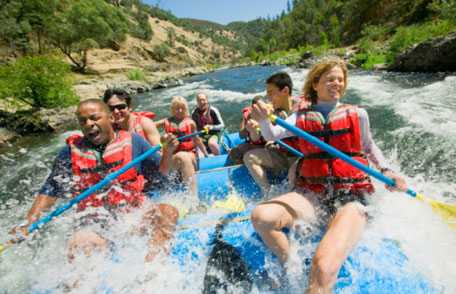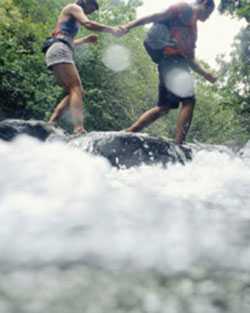Leptospirosis Risk in Outdoor Activities
 People who enjoy outdoor activities where freshwater or wet soil are encountered may be at risk for leptospirosis. This includes swimming, kayaking, rafting and canoeing in freshwater, hiking and camping. Learn how to help prevent infection and stay safe outdoors.
People who enjoy outdoor activities where freshwater or wet soil are encountered may be at risk for leptospirosis. This includes swimming, kayaking, rafting and canoeing in freshwater, hiking and camping. Learn how to help prevent infection and stay safe outdoors.
Leptospirosis is a disease caused by Leptospira bacterial species. These bacteria are carried in the urine of infected animals such as rodents, pigs, cattle, dogs, and many wildlife species. If urine from an infected animal is deposited or drains into a body of fresh water (lake, river, stream, etc.) or soil, the bacteria can survive there for weeks to months.
Leptospirosis exists worldwide, but it is more likely to be found in tropical climates. The risk of infection is higher after a heavy rain or flooding.
How People Get It
People may come into close contact with fresh water or wet soil when they participate in outdoor activities. If the water or soil was contaminated with bacteria that cause leptospirosis, that person could be at risk for developing the disease. The bacteria can enter the body through the eyes, nose, mouth or skin cuts and abrasions. Prolonged immersion in or swallowing of contaminated water can increase the risk of infection. Direct contact with the urine, other bodily fluids, or tissues of infected animals can also lead to infection, as well as ingestion of food or water contaminated by Leptospira.
Participating in sporting and racing events that include kayaking, canoeing, swimming, off-path trekking and other similar types of outdoor activities can increase the risk of leptospirosis infection. These activities – sometimes called “adventure racing” – often involve entering bodies of fresh water and/or contact with soil for long periods of time.

You may be at risk for leptospirosis when you participate in outdoor activities where freshwater or wet soil are encountered. Learn how to protect yourself and stay safe outdoors.

Kayaking, canoeing, swimming, off-path trekking and other similar types of outdoor activities can increase your risk of leptospirosis infection. Know the symptoms and see a doctor if you think you may have leptospirosis.
Symptoms
Symptoms may appear anywhere from two days to four weeks after exposure to the bacteria. Most infections result in mild, flu-like symptoms or no symptoms at all. When symptoms occur they can include:
- Fever
- Headache
- Chills
- Muscle and/or joint pain
- General weakness
- Eye redness
- Nausea or vomiting
- Diarrhea
- Abdominal pain
- Cough
- Rash
However, 5 to 10 percent of cases can develop more severe, potentially life-threatening disease, affecting multiple organs, including the kidneys, liver, brain, lungs and heart.
How You Can Reduce Your Risk
If your outdoor activities will involve fresh water or wet soil, you can take steps to lower your chances of getting leptospirosis.
- Research the area in which you will be spending time outdoors, and be aware of potential risks—especially if you’re going somewhere new on vacation. (See CDC’s Travelers’ Health Yellow Book.)
- Wear protective clothing and shoes – avoid walking barefoot in areas with potentially contaminated standing water or mud.
- Wait until cuts or scrapes are healed before going into fresh water or wet soil. (If you can’t wait, cover cuts and scrapes with watertight bandages.)
- Try to avoid going under water or swallowing water in potentially contaminated lakes, rivers or swamps.
- Wash your hands and face with soap and water after contact with fresh water or damp soil.
- If exposure to potentially contaminated water or wet soil is unavoidable, consider talking to your health care provider about taking medicine that may help prevent leptospirosis.
If you have recently been in fresh water, wet soil or mud and develop symptoms of the disease, be sure to see a doctor as soon as possible. The doctor can provide testing for leptospirosis and treatment if needed. Early treatment can help reduce the severity and duration of symptoms caused by leptospirosis.
Head out and enjoy the great outdoors this summer, and take it all in—just not leptospirosis.
More Information
More Information
For more information on Leptospirosis, visit the following links:
- Page last reviewed: July 5, 2016
- Page last updated: July 5, 2016
- Content source:
- National Center for Emerging and Zoonotic Infectious Diseases (NCEZID), Division of High-Consequence Pathogens and Pathology (DHCPP)
- Page maintained by: Office of the Associate Director for Communication, Digital Media Branch, Division of Public Affairs




 ShareCompartir
ShareCompartir